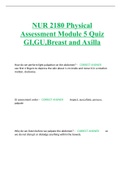Essay
Linguistic Paper English Linguistics 5 Language in Society
- Instelling
- Universiteit Van Amsterdam (UvA)
This is my linguistic paper (''Double-Voiced Discourse in Female-Dominated Workplaces'') for the course English Linguistics 5 Language in Society, which I received an 8 for! You can use this essay as an inspiration for your own linguistic research, e.g. conduct the research.
[Meer zien]













